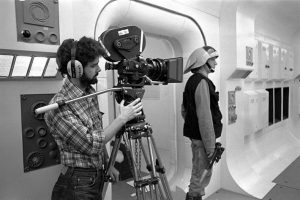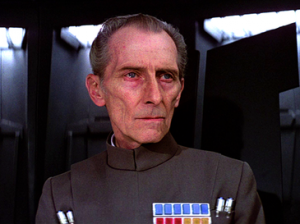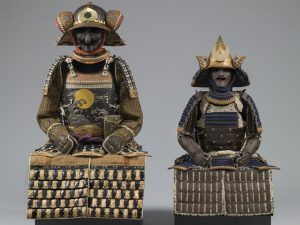The Portrayal of the Familiar and the Exotic in Debuting Star Wars Films
“What does need to be questioned, however, is the mode of representation of otherness.”
– Homi K. Bhabha
The Star Wars franchise is best known for its three main trilogies following the path of the Skywalker family, yet between the making of the first movie of each trilogy (Star Wars: A New Hope, Star Wars: The Phantom Menace, and Star Wars: The Force Awakens) lies a stretch of fifteen to twenty years. This generational gap means that the audience of Star Wars has experienced changes in opinion between each release and therefore, so has the style in which each movie was made. Yet despite the changes in characters, technology, and subliminal commentary within each movie, there exists an identical underlying parabolic structure of storyline to each film and similar representation of orientalism and the alien other. Although each opening Star Wars film changed on a surface level between each trilogy, their core structures and methods of representation of non-humans remain the same.
At first glance, the beginning film of each Star Wars trilogy appears significantly unique from its predecessors. A New Hope is famous for its entirely hand-made sets and its lingering sense of hope. The Phantom Menace is known for being the first film to rely almost solely on computer-generated imagery (CGI). Finally, The Force Awakens is best known for its modernization of many of the beloved features from the original trilogy through the use of both CGI and handmade sets and props. Pictured below are photographs from the sets of A New Hope, The Phantom Menace, and The Force Awakens.

The Set of A New Hope

The Set of The Phantom Menace

The Set of The Force Awakens
Despite the various technological and visual changes between each debuting Star Wars film, identical parabolic storyline arcs can be found beneath the initial sensory aesthetics. According to David Wyatt, the storyline arcs of epics can be defined as “…long stories that return upon themselves, stories which continually predict and echo their emerging shape.” Wyatt goes on to argue that the entire saga forms a parabolic structure of rises and falls of governments, armies, religious creeds, and characters. With regards to the opening film of each trilogy, parallel storyline structures exist across all three. All three films begin with the classical hero’s call to adventure in which the protagonist, an agent of good, is summoned to abandon their current situation to combat evil. One example of this is lies in the opening of The Force Awakens, when the protagonist Rey meets a First Order deserter Finn and joins him in leaving her home planet of Jakku to join the Resistance. In the case of all three movies the protagonist accepts their call to adventure, which then leads to an adventure across the galaxy ridden with various moral tests.
Outside of the hero’s journey, the parabolic arch of each movie can be found all throughout each debuting film. The films begin at a low point in a theoretical parabola, with an evil power threatening civilian lives (in this case the Separatist blockade, the Empire, or the First Order). Then a force of good (the Republic, the Rebellion, or the Resistance) challenges the evil power for the sake of innocent civilians. Once challenged, throughout A New Hope, The Phantom Menace, and The Force Awakens the good force generally prevails in battle, bringing the movie to a high point for the viewer as each movie’s representation of evil is defeated; however, this is short-lived as by the next film the parabolic structure is brought back to the same low point when an adapted form of evil rises from the ashes of the prior form and once again threatens innocent civilian lives. The primary reason all the Star Wars film structures exist in a continuous parabola is that the “evil” power is always imperialist.
This notion of a struggle against an imperial power then brings in the idea of how each side is portrayed visually in each movie. In his essay The Tao of Star Wars, Kevin J. Wetmore argues that “The film…on the surface at least, demonstrates a post-colonial struggle against imperialism. The language of the Star Wars saga is that of the colonialist enterprise.” The way in which the films are presented very much present a parallel to the 19th and 20th century struggles against imperialist powers by many African, South American, Asian, Middle Eastern, Caribbean, and Central American nations. Whether it be the Empire attempting to bring “order” to the galaxy or the Separatists trying to impose seamless economic policies across all planets, the evil forces in Star Wars always fall into the place of a patronizing imperial power. Wetmore also argues that further evidence of this comes in the choice of the naming of characters. The evil characters are all given Western names with negative connotations such as Darth Sidious (derived from the English word insidious) or Darth Maul (derived from the English word maul) whereas the good characters are given Eastern names such as Obi-Wan Kenobi (derived from the Japanese language) or Qui-Gon Jinn (derived from the Chinese language). This implies a struggle of diverse Eastern independence against mechanical Western imperialism.
That then leads to the notion that orientalism is heavily present throughout all three films. Edward Said, who first coined the term orientalism, defines it as, “…a style of thought based upon ontological and epistemological distinction made between “the Orient” and (most of the time) “the Occident.” In other words, orientalism is the idea that when Western artists write or create art about the East, they tend to portray it in a both patronizing and mystifying way based on their own false beliefs stemming from colonialist times. Lucas entices his viewers by displaying both the good forces and surrounding static characters as Eastern or alien others, something that has long mystified Western viewers. Through many details such as naming, costuming, and characterizing Lucas paints an orientalist portrait of the far reaches of the galaxy in all of his opening films. Humans remain the dominating force in Star Wars and English remains the primary language of the galaxy–Galactic Basic Standard–yet the Galactic Standard alphabet loosely resembles the Japanese alphabet. Galactic Basic Standard serves as a prime example of how Lucas entices the audience with orientalist ideas yet maintains a relatable narrative by integrating enough Western ideas to make concepts understandable. In addition, a character speaks does not speak Galactic Basic is forced into the category of the “other” and is estranged them from the main human storyline.
Furthermore, Lucas and Abrams’ choices of costuming for all characters in the A New Hope and The Force Awakens stand as strong indicators of their use of orientalism to cater to a Western audience. A majority of the characters in the three debuting movies are portrayed as Eastern to create an exotic aesthetic throughout the storyline, whereas the rest are portrayed as more Western to provide the audience with a sense of familiarity and relatability. This choice of costuming gives the movies a mystical appearance while not straying too far away from Western comforts and standards. Some examples of using Western costuming this throughout both movies include Grand Moff Tarkin in A New Hope (whose uniform is similar to that of a United States army officer) and General Hux in The Force Awakens (whose uniform resembles all-black Western business attire). The use of orientalist costuming can be seen on Darth Vader in A New Hope (whose armor imitates traditional Japanese samurai armor) and Rey in The Force Awakens (whose main costume looks similar to robes worn by Buddhist monks). While the idea to utilize Eastern-inspired costuming caused massive success with Western audiences, it still neglects to educate the audience on Eastern history or pay credit to the primary inspiration.

General Hux

Grand Moff Tarkin

Darth Vader

Traditional Samurai Armor on Display at the Cincinnati Art Museum

Rey

Bhikkhus in a Buddhist Monetary in Thailand
On the other hand, in The Phantom Menace almost all costumes are derived from various Eastern armors and garbs. Both good, bad, and neutral characters alike don robes and armor that are strikingly oriental in appearance, once again utilizing these costumes to illustrate the characters as foreign or alien. This fuels the Western conception that Eastern cultures are a foreign other, making the costuming of The Phantom Menace an orientalist construct. Furthermore, almost all of the protagonists are caucasian humans, with the exception of Jar Jar Binks, who is noticeably foreign in appearance and whose role was intended to provide comic relief to the audience. This example of Jar Jar Binks being a laughable foreign other counts on the Western audiences ability to distance themselves from the foreign other. Based on the prior information, The Phantom Menace was the most orientalist film of the three debuting Star Wars films.
Ultimately all three debuting films of the Star Wars saga contain the same underlying parabolic storyline arcs and orientalist influences which led them to become so immensely successful with Western audiences. Because all three movies were geared towards a Western audience with little understanding of Eastern culture and history, the recurring misrepresentations of Eastern culture went largely unchecked. It is evident from the repeating trends in the storyline structure and use of Eastern exoticism that what mattered most to the producers of Star Wars was not the education or awareness of the audience but the amount of money they could gain from theaters. If the storylines of each movie could continue to rise and fall as new and mysterious characters came and went, the audience would continue to return, boosting box office sales to incredible levels.
Annotated Bibliography
David Wyatt, “Star Wars” and the Productions of Time. The Virginia Quarterly Review 58, no. 4 (1982): 600-15.
This journal presents the idea of the nine-movie Star Wars saga as an epic much like the
Iliad or Paradise Lost. Through their structures each of the main Star Wars films fit into a
generational epic that’s structure loops back on itself in the same manner, simply with different characters and settings. I primarily pulled definitions from this article to help articulate my own argument about the Star Wars canon.
Edward Said, Orientalism, New York: Pantheon Books, 1978, 1-5.
The beginning of Said’s book Orientalism provides valuable insight into what he believes
orientalism is as well as providing a clear definition of the concept. I used the opening
few pages of the book to gain a better understanding of orientalism from its creator and
to pull Said’s exact definition for my essay.
Eric Molinsky, Episode 27: 1977, Imaginary Worlds. Podcast audio. 2016. https://www.imaginaryworldspodcast.org/1977.html
This podcast, hosted by Eric Molinsky and featuring Kurt Andersen, Annalee Newitz,
Alyssa Rosenberg, and Chris Taylor, gives insight into the cultural context surrounding the release of Star Wars: A New Hope. Touching on audience reactions, world events, and critical opinions, the podcast provided me with a brief but all-encompassing picture of how Star Wars was first perceived.
George Lucas, Star Wars: A New Hope. Digital download. Directed by George Lucas. Los Angeles: 20th Century Fox, 1977.
The first Star Wars film to be released for the saga, A New Hope tells the Western-style
tale of Luke Skywalker on his journey through the galaxy to leave his home planet, train
train to become a Jedi, rescue the Princess Leia, and destroy the menacing Death Star.
This film was watched and analyzed in order to be utilized as a comparative tool with its
later sequel and prequel.
George Lucas, Star Wars: The Phantom Menace. Digital download. Directed by George Lucas. Los Angeles: 20th Century Fox, 1999.
The fourth installment in the Star Wars saga, The Phantom Menace tells a story of the
young boy Anakin’s escape from his home planet to train as a Jedi under Obi-Wan
Kenobi. Meanwhile a trade blockade imposed on the planet Naboo leads to an outbreak
of war between the Separatists and the Republic. This film was watched and analyzed to
be used as a comparative tool with its sequel films.
J. J. Abrams, Lawrence Kasdan, and Michael Arndt, Star Wars: The Force Awakens. Digital download. Directed by J. J. Abrams. Burbank: Walt Disney Studios Motion Pictures, 2015.
The seventh iteration of the primary Star Wars saga, The Force Awakens tells the story of
the young girl Rey who escapes her home planet to join the Resistance with First
Order deserter Finn. The two later help the Resistance battle a planet-destroying battle
station in an effort to save the galaxy from imperial rule. This film was watched and
analyzed to be used as a comparative tool with its prequel films.
Jeremy Singer, The Man Who Literally Built ‘Star Wars’, Esquire, May 4, 2014.
This news article is an interview between journalist Jeremy Singer and Star Wars: A New
Hope set designer Roger Christian. In the interview Christian explains how he came to
become the set designer for George Lucas, how he overcame the obstacle of a small
budget, and how his team of set designers built the entirety of Star Wars: A New Hope by
hand. I used this article to help illustrate a point about what made Star Wars: A New
Hope so memorable in comparison to later films in the saga.
Kevin J. Wetmore, The Tao of “Star Wars”, Or, Cultural Appropriation in a Galaxy Far, Far Away. Studies in Popular Culture 23, no. 1 (2000): 91-106.
This journal article examines the presence of Western and Eastern cultural norms
throughout the Star Wars film series. It also explains how director George Lucas
chose to portray these cultural norms in his films and whether that is a sign of cultural
appropriation or not. I used this source as a foundation for my arguments about
xenophobia, orientalism, and stereotyping in my three chosen Star Wars films.
Robert J. C. Young, Postcolonialism: A Very Short Introduction, New York: Oxford University Press, 2003.
This book summarizes modern postcolonial theory through a mixture of definitions and
real-life examples. It introduces concepts such as imperialism, landlessness, and
orientalism through a combination of the author’s opinions and other postcolonial
scholars’ views. I cited various scholarly quotations and based the majority of my essay
on Young’s idea of postcolonial theory.

Rachel Blair’s essay talks about how the “other” is portrayed in the Star Wars canon, she adheres to Edward Said’s Orientalism and the perception we receive from dressing the Rebels like an exotic oriental culture. She also writes also about the familiarity of the west being depicted by western clothing. She concludes that the movie was produced in order to sell tickets and not to educate the western world on eastern culture. Where she fails to make the point is that the exoticism of characters is not only about the Jedi but the sith lords also, and furthermore, the westernization by clothing also happens around the soldiers and pilots that serve the resistance and the rebel alliance. I would argue that the orientalized others are those who can use the force and its counterpart. The generalization that it’s only the rebels that are portrayed as the “other” is wrong. If we were to strip both entities from the force users, you’d have two uniformed entities fighting each other, two armies. Consider the idea that its the higher ups, like the Sith’s and Jedi’s, who manage the rhetoric about demonizing the other. Furthermore, I think a better case to make, rather then orientalism is the cultural appropriation through the clothing of “other” cultures. This argument would have so much more footing if she had focused on how imperialistic cultures used the “others” clothing to culturally appropriate and use their robes in order to boost box office tickets.
She is not wrong about Hollywood’s model to make money at the box office, but that’s just the nature of the business. Consider the franchise of Star Wars, the parabolic storyline does aid the ultimate goal of crushing the box office. The Star Wars franchise is worth more than Harry Potter and James Bond combined. The goal of every movie produced in Hollywood is to make money.